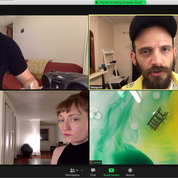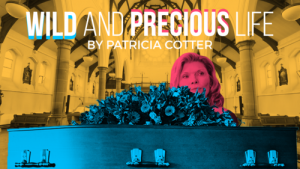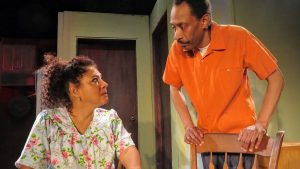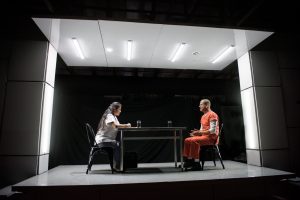
PTP/NYC is known for producing politically aware plays. They present theatrically complex and thought-provoking works of contemporary social and cultural relevance. For their abbreviated season this year, they are streaming four productions over four weeks. The second one, Don’t Exaggerate (desire and abuse), certainly fits the bill. Howard Barker’s work is subtitled, “a political statement in the form of hysteria.”
This forty minute stream of consciousness is delivered by Robert Emmet Lunney. He portrays a Hungarian soldier who was killed in World War I. His spirit, however, is back to make commentary about the world since then. This monologue was first performed in 1984 and is not dated one bit. So many off-hand remarks land darkly and humorously but also feel current.
Right from the start, you understand why this piece is on this theater company’s schedule this year. “The truth is dying / It is praised so much / Don’t keep on about the truth.” Death is a major theme which perhaps seems obvious from a dead war soldier. The tone is serious and blunt with comments like “suicide is the highest moment of consciousness.” He views Europe as “death’s estate.” Later in the show, truth and death combine and we are made to realize “the dead have all the facts.”
All is not gloom and doom in this wildly non-linear wordplay. The world is an “avalanche of falling periodicals” and “everyone is in print.” Written over three decades ago, that observation is even more true today. Social media and non-stop news cycles make for a never ending avalanche.
There are many societal zingers scattered throughout which entertain. One particular favorite was “never underestimate the reproductive powers of the decadent.” Mr. Barker has a disgusting opinion of mankind in general. That viewpoint pops up in serious commentary and also in hilarious one liners including a throwaway line about hearing “choruses of violated sheep.”
Climate change hits hard here as well. Rising temperatures of the planet are contributing to cancers in the population. A little later on, he comes back to this notion and links back to his running commentary about truths. An “increase in cancers” is equivalent to an “increase in lies.” There are so many fascinating parallels to our 21st century cavalcade of large scale dramas happening worldwide.
Here’s a tip: “you can always take an intellectual for a ride if you stare into his eyes.” I love Mr. Barker’s writing and the rambling style which managed to loop around in a whirlpool of sarcasm and despair.
The central performance by Mr. Lunney could have dripped with even more sarcasm. I wonder if the monologue might come across differently spoken by a young man rather than one wiser with age. A fresh faced soldier who has an axe to grind. The acerbic tone might be even more disconcerting. The live streaming, however, was a great medium to appreciate this work. Director Richard Romagnoli’s in-your-face close ups kept the focus intense.
Don’t Exaggerate (desire and abuse) is available on PTP/NYC’s You Tube channel through Sunday, October 4, 2020. The next production is Dan O’Briens The House in Scarsdale: A Memoir for the Stage beginning October 8th.












You must be logged in to post a comment.